Double-Recessive Genetics
Okay, hopefully y'all have a fairly decent grasp of simple recessive genetics. Now it's on
to the fun stuff!
First of all, what's a double recessive? It's exactly like it sounds: a snake with two
different sets of recessive genes. The example I'm going to use throughout this page is the
Snow morph. Snows are Axanthic Albinos. Axanthics are snakes without yellow (they look like
black and white photographs of normal ball pythons), and Albinos, whether you're talking about
snakes, mice, or people, remove all dark pigment. If you think about it, you can figure out
what a Snow would look like: the Axanthic removes all yellow, and the Albino removes everything
but the yellow! So you end up with a white snake with red eyes! Most Snows still have a little
bit of yellow, but if you use pure black and white Axanthics that don't brown out, you should
end up with a completely white snake.
Okay, so how do we get one of these? First instinct may be to cross an Albino with an Axanthic.
Remember we need to include all genes we're working with, even if a specific recessive gene
doesn't exist for that particular snake. For example, the Albino will be aaXX and the Axanthic
will be AAxx. The snakes will pass on one gene from each pair, so the Albino can pass aX, aX, aX,
aX and the Axanthic can pass Ax, Ax, Ax, Ax. Also remember that we can't just ignore duplicates;
there are four possible combinations for each snake, not just two. So let's Punnett square these
puppies!
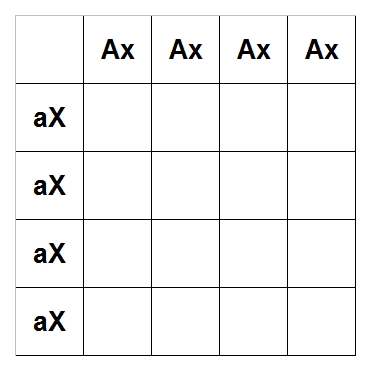
If you want to simplify these charts, you can do so like we did with the Co-Dominant genetics:
you want to multiply the final percentages for the repeated lines by the number of repeated lines
you have. So if you have two duplicate rows, you can remove the duplicate row in the Punnett
square and multiply the percentages from that row by two. If you have three duplicate rows,
multiply by three. In this case, we have four duplicate rows, so we can remove all rows but
one and multiply that row by four when we're done.
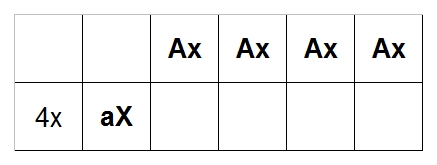
I will be doing this from now on to make things easier. At least, I hope it makes things easier....
Okay, now do the usual filling in the chart.
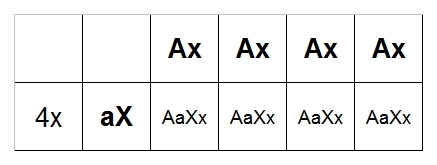
This one's easy: all offspring are the same, and they are all het for both Albino and Axanthic.
Most refer to this as being double het for Snow or double-het Albino and Axanthic. Recall that
hets look like normals, so all offspring will look completely normal.
Obviously, we didn't get our Snow, so let's take these double hets and breed those together. From
the above chart, we see that double hets are AaXx, so each snake can pass AX, Ax, aX, ax.
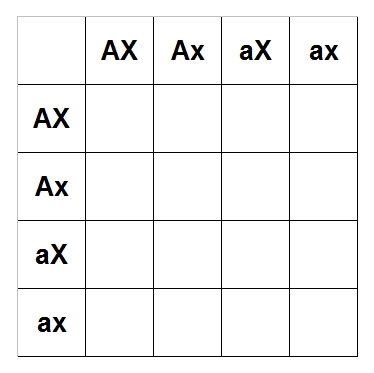
Fill it in, blah blah....
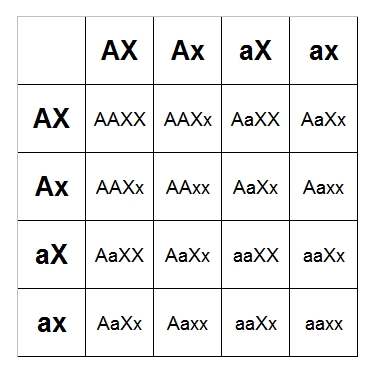
Oookay, this is going to be a little more complicated, but not by much, really. I've color-coded
the repeat cells to make it a bit easier this first time.
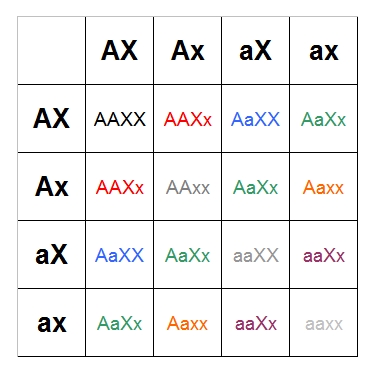
AAXX = Normal = 1/16 = 6.25%
AAXx = Het Axanthic = 2/16 = 1/8 = 12.5%
AAxx = Axanthic = 1/16 = 6.25%
AaXX = Het Albino = 2/16 = 1/8 = 12.5%
AaXx = Double het Albino Axanthic = 4/16 = 1/4 = 25%
Aaxx = Axanthic het Albino = 2/16 = 1/8 = 12.5%
aaXX = Albino = 1/16 = 6.25%
aaXx = Albino het Axanthic = 2/16 = 1/8 = 12.5%
aaxx = Albino Axanthic (Snow) = 1/16 = 6.25%
Okay, let's see what we have. The main thing you'll notice is that we have only a 1 in 16 chance
of hatching a Snow from this combination. Not great odds, but not terrible either, and this
is probably the cheapest way to produce double recessives. However, we still have to deal
with the hets and trying to figure out what the percentage of hets we have is.
Let's start with the Axanthics. We have 3/16 snakes that look Axanthic, but two of those are also
het Albino. So 2/3 Axanthics are het Albino, so all the Axanthics from this clutch are 66% het
Albino. Same goes for the Albinos: 2/3 Albinos are het Axanthic, so all the Albinos will be
66% het Axanthic.
Now let's do the normals. We have 1/16 normal-normals, 2/16 het Axanthics, 2/16 het Albino, and
4/16 double het: 9 snakes total. So 6 of these 9 are het Axanthics: 6/9 = 2/3 = 66%! Same
goes for the het Albinos: 6/9 = 2/3 = 66%! That means that each normal from this clutch
will be 66% het Axanthic and 66% het Albino! Or, in other words, each normal is 66%
double het! Now, this doesn't mean that if one of these normals proves to be het Albino, it
will also be het Axanthic. It could be double het...or it could just be het Albino.
Whew. Okay. Now, what if you don't like only having a 1/16 chance of getting a Snow? Well, there
are other ways to do it, too.
First, let's try an Axanthic het Albino x double het Snow, or Aaxx x AaXx. The first snake can
pass on Ax, Ax, ax, ax, and the second snake can pass on AX, Ax, aX, ax.
(Coming soon!)

|






